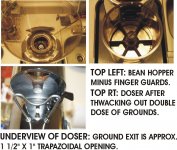chluk2425
New member
I've been looking through forms, posts, google-ing about storage of roasted beans and grounded coffee after grinding it, but everytime i came across is "using a air tight / seal jar to store it" .
Is there any recommendation on good air tight jar/box for it? I initially got a lock n lock box to store my beans and grounded coffee, but then few days later, my cupboard is full of coffee bean's smell... looks like it's not very air tight... I found something like below, a lever arm glass jar, is it recommended?
Thank you
Is there any recommendation on good air tight jar/box for it? I initially got a lock n lock box to store my beans and grounded coffee, but then few days later, my cupboard is full of coffee bean's smell... looks like it's not very air tight... I found something like below, a lever arm glass jar, is it recommended?
Thank you



